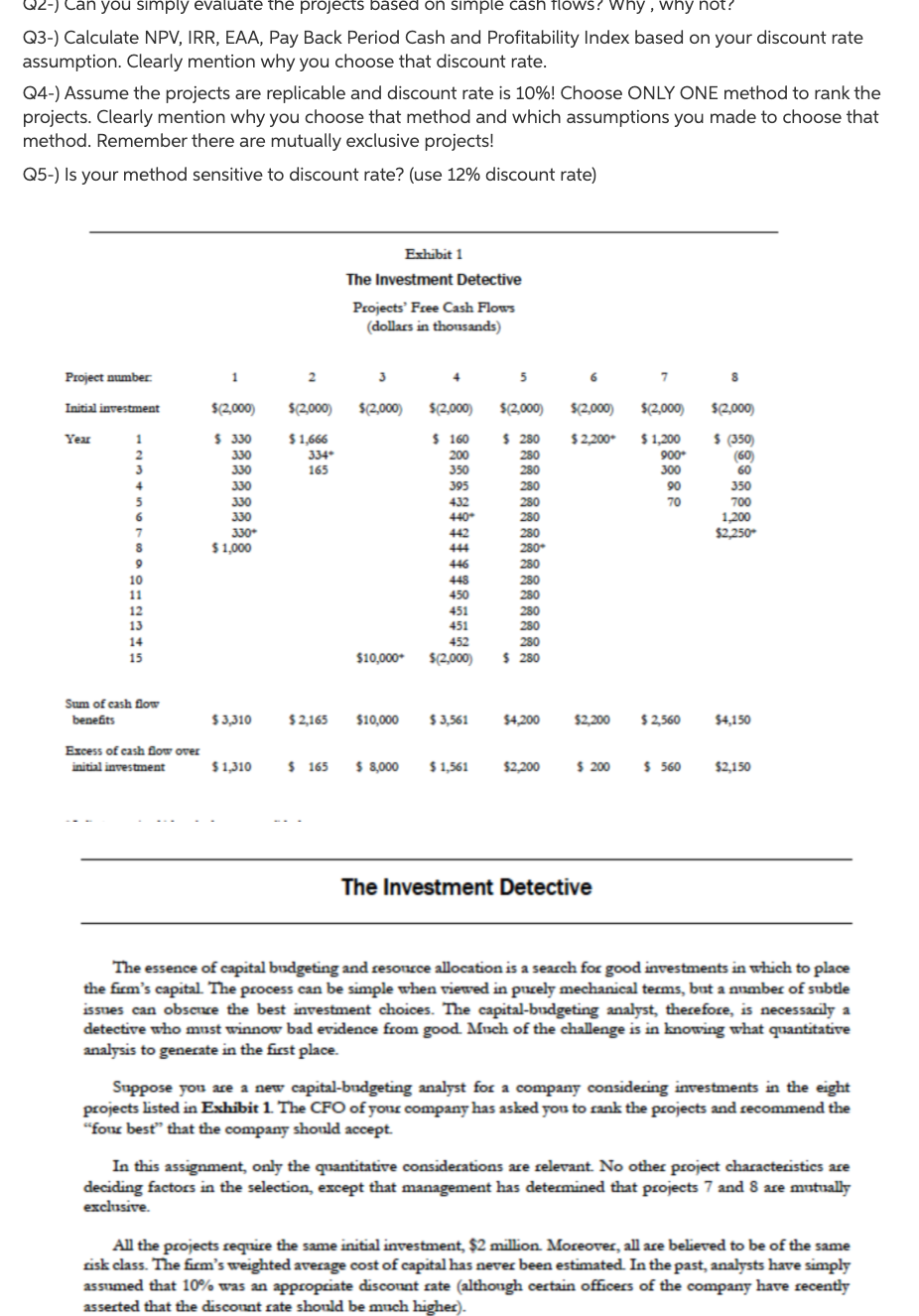
Q2-) Can you simply evaluate the projects based on simple cash flows? Why, why not? Q3-) Calculate NPV, IRR, EAA, Pay Back Period Cash and Profitability Index based on your discount rate assumption. Clearly mention why you choose that discount rate. Q4-) Assume the projects are replicable and discount rate is 10%! Choose ONLY ONE method to rank the projects. Clearly mention why you choose that method and which assumptions you made to choose that method. Remember there are mutually exclusive projects! Q5-) Is your method sensitive to discount rate? (use 12% discount rate) Exhibit 1 The Investment Detective Projects' Free Cash Flows (dollars in thousands) Project number 1 2 5 6 7 Initial investment $(2,000) $(2,000) $(2,000) $(2,000) $(2,000) $(2,000) $(2,000 $2,000 Year 1 $2,200 $ 330 330 30 330 $1,666 334 165 $ 160 200 350 395 432 4404 $ 1,200 900 300 90 70 $ 350) (60 60 350 700 1.200 $2.250" 330 330 $1,000 444 446 448 450 451 451 452 $(2,000) $ 280 280 280 280 280 280 280 280 280 280 280 280 280 280 $ 280 $10,000 Sum of cash flow benefits $3,310 $2,165 $10,000 $3,561 $4,200 $2,200 $2,560 $4,150 Escess of cash flow over initial investment $1,310 $ 165 $ 8,000 $ 1,561 $2,200 $ 200 $ 560 $2,150 The Investment Detective The essence of capital budgeting and resource allocation is a search for good investments in which to place the firm's capital. The process can be simple when viewed in pucely mechanical terms, but a mmber of subtle issues can obsence the best investment choices. The capital-budgeting analyst, therefore, is necessarily a detective who must winnow bad evidence from good Much of the challenge is in knowing what quantitative analysis to generate in the first place. Suppose you are a new capital-budgeting analyst for a company considering investments in the eight projects listed in Exhibit 1. The CFO of your company has asked you to rank the projects and recommend the "for best that the company should accept In this assignment, only the quantitative considerations are relevant. No other project characteristics are deciding factors in the selection, except that management has determined that projects 7 and 8 are mutually exclusive All the projects require the same initial investment, $2 million Moreover, all are believed to be of the same risk class. The firm's weighted average cost of capital has never been estimated. In the past, analysts have simply assumed that 10% was an appropriate discount sate (although certain officers of the company have recently asserted that the discount cate should be much higher). Q2-) Can you simply evaluate the projects based on simple cash flows? Why, why not? Q3-) Calculate NPV, IRR, EAA, Pay Back Period Cash and Profitability Index based on your discount rate assumption. Clearly mention why you choose that discount rate. Q4-) Assume the projects are replicable and discount rate is 10%! Choose ONLY ONE method to rank the projects. Clearly mention why you choose that method and which assumptions you made to choose that method. Remember there are mutually exclusive projects! Q5-) Is your method sensitive to discount rate? (use 12% discount rate) Exhibit 1 The Investment Detective Projects' Free Cash Flows (dollars in thousands) Project number 1 2 5 6 7 Initial investment $(2,000) $(2,000) $(2,000) $(2,000) $(2,000) $(2,000) $(2,000 $2,000 Year 1 $2,200 $ 330 330 30 330 $1,666 334 165 $ 160 200 350 395 432 4404 $ 1,200 900 300 90 70 $ 350) (60 60 350 700 1.200 $2.250" 330 330 $1,000 444 446 448 450 451 451 452 $(2,000) $ 280 280 280 280 280 280 280 280 280 280 280 280 280 280 $ 280 $10,000 Sum of cash flow benefits $3,310 $2,165 $10,000 $3,561 $4,200 $2,200 $2,560 $4,150 Escess of cash flow over initial investment $1,310 $ 165 $ 8,000 $ 1,561 $2,200 $ 200 $ 560 $2,150 The Investment Detective The essence of capital budgeting and resource allocation is a search for good investments in which to place the firm's capital. The process can be simple when viewed in pucely mechanical terms, but a mmber of subtle issues can obsence the best investment choices. The capital-budgeting analyst, therefore, is necessarily a detective who must winnow bad evidence from good Much of the challenge is in knowing what quantitative analysis to generate in the first place. Suppose you are a new capital-budgeting analyst for a company considering investments in the eight projects listed in Exhibit 1. The CFO of your company has asked you to rank the projects and recommend the "for best that the company should accept In this assignment, only the quantitative considerations are relevant. No other project characteristics are deciding factors in the selection, except that management has determined that projects 7 and 8 are mutually exclusive All the projects require the same initial investment, $2 million Moreover, all are believed to be of the same risk class. The firm's weighted average cost of capital has never been estimated. In the past, analysts have simply assumed that 10% was an appropriate discount sate (although certain officers of the company have recently asserted that the discount cate should be much higher)







